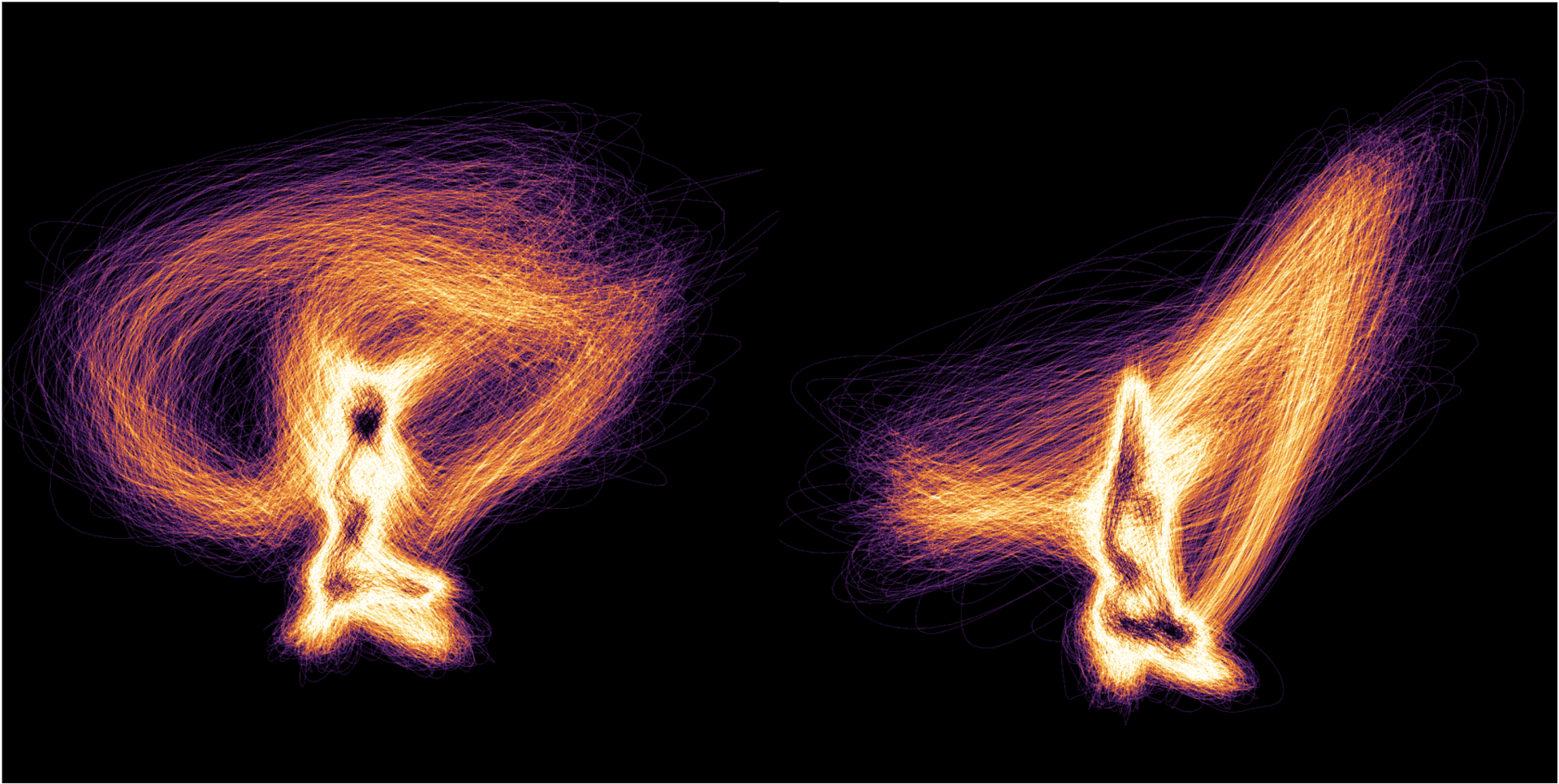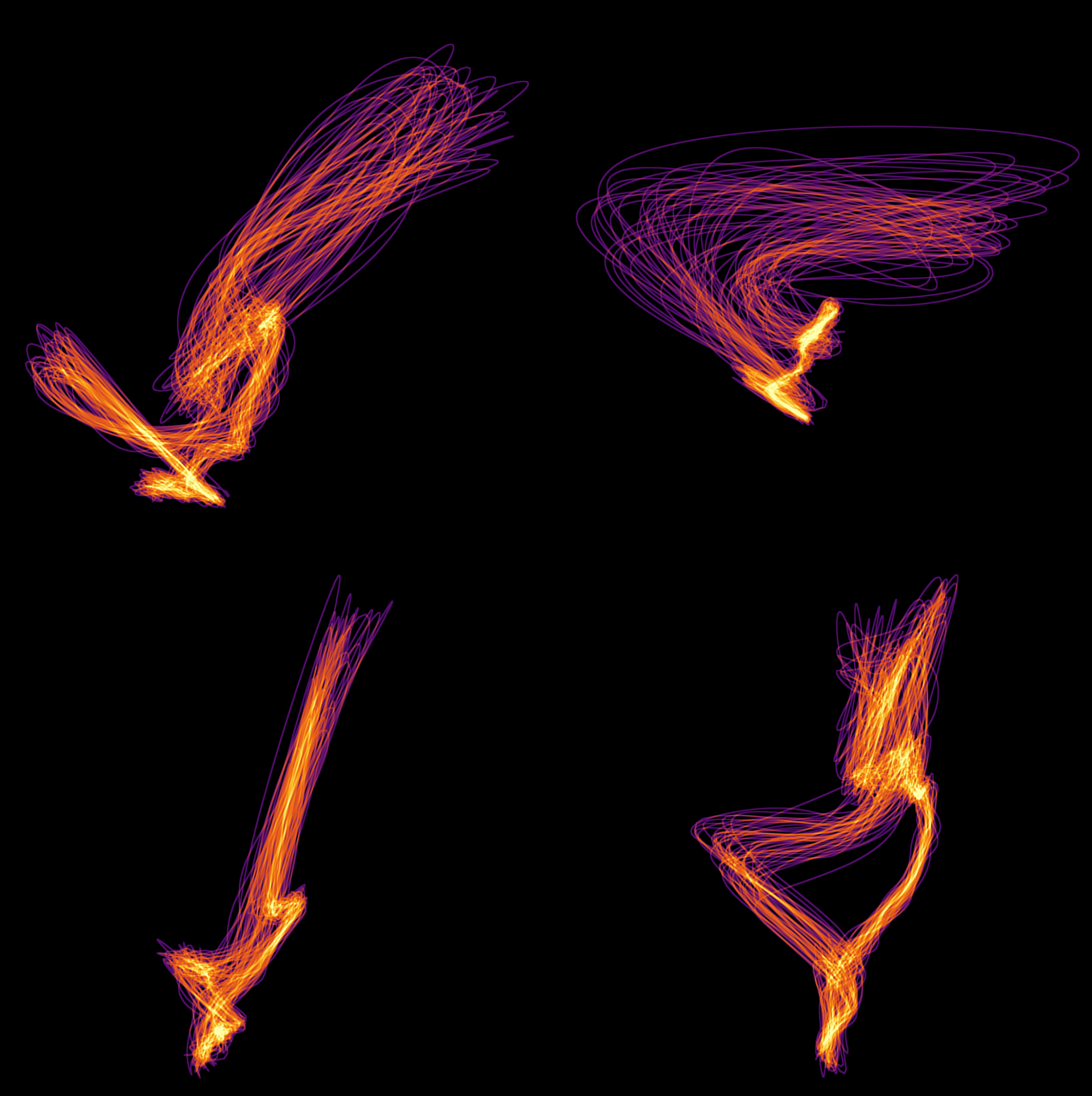Feeling the Force: How Physics Helps Us ‘See’ the Beauty of Running
In the biomechanics of running, science and art converge.

Growing up in England in the mid-1970s, cross-country races involved battling wild and icy Arctic winds, wading through deep and icy rivers, and clambering up steep and icy mudbanks. Pretty much everything was icy during those midwinter challenges.
Sunshine arrived in the form of my running coach, Wilf Richards, who bore a striking resemblance to the coach in Chariots of Fire, the 1981 film drama about two British athletes in the 1924 Olympic Games. My teammates joked he looked old enough to have joined his doppelganger in those Olympics.
I sometimes reminisce about him clutching his stopwatch as I passed in the rain, shouting lap times or his old battle cry — “Einstein was wrong!” — as though it might boost our running speed faster than, well, the speed of light.
Wilf didn’t have much in the way of equipment to measure our progress. His stopwatch would jam half the time, and he’d calculate the distances of our runs using a strange implement donated by our geography teacher. A little wheel at one end was run along the surface of a map while a dial at the other end showed the distance. The method was so precarious that a bad crease could easily add 500 meters. Despite the challenges, he’d pour over the data scribbled down in his long tables and periodically issue profound declarations such as, “If you want to run fast, you’re going to have to run fast.”
Wilf’s only piece of reliable equipment was his eye. Even though running is the simplest of sports — you just put one foot in front of the other — he could tell when it was performed with beauty. Yet like many great art scholars, he struggled to capture this beauty in precise words and numbers. I don’t blame him: Strange things can emerge from this beauty.
As an example from the mid-1970s, Bill Rodgers won the Boston and New York Marathons four times each. Those races added up to about 450,000 strides for Bill — all performed beautifully, despite one leg being a half-inch shorter than the other. From more recent times, consider Femke Bol, the Dutch track and field athlete. Speeding down the final stretch, she was just a few meters away from winning a gold medal at the 2023 World Championships. As the holder of the 400-meter indoors world record, she’d practiced putting one foot in front of the other millions of times. And yet, with the world watching, she fell. She couldn’t explain why. (She showed her talent most recently at the 2024 Olympics in Paris, where she won a gold medal.)
Along with all other physics professors, I don’t like these running puzzles. I like to cram my General Physics classes with well-explained sports demonstrations. If you want your golf ball to fly far, try launching it at 45 degrees. If you want to spin fast, tuck your arms close to your body. Skeptics walk away convinced that the power of physics can solve any sports riddle.
What, then, can physics tell runners? About 10 years ago, this question went beyond academic interest when I learned an interesting statistic the hard way: At any one time, a quarter of runners are injured. I should have listened to Wilf’s prediction: “Your Achilles heel will be your Achilles heel.”

As is typical of people who spend a lot of time running, I also spend a lot of time with my physiotherapist. In fact, I’ve spent so much time with Sean Roach that he has become my close friend. We talk a lot about the beauty of running during my sessions. Recently, we’ve recruited two of my previous physics students, Cooper Boydston and Conor Rowland, to help turn this talk into action by utilizing the latest running technology.
These days, when I set out for a run, satellites follow my progress with precision and beam my progress to the ‘watch’ on my wrist. Perhaps sadly, virtual training partners have now replaced my teammates, although I like to imagine that my old friends’ runs are being tracked by those same satellites.
No doubt, Wilf would have embraced these advances, as long as they helped in his search for beautiful running. Thinking back to his tables of scribbled numbers, I suspect he would have worried that the sheer amount of data could overwhelm any hope of making sense of it all. Of course, this dilemma goes well beyond running. It lies at the heart of all of today’s “big data” projects.
My approach to handling complex running data came from another search for beauty. Around the time that I was running in (track) circles around Wilf, I found an art book at a yard sale that featured the abstract paintings of Jackson Pollock. I’ve been mesmerized by his work ever since. During the 1950s, Pollock rolled out huge canvases across the floor of his barn and poured paint from a can. A remarkable demonstration of Action Art, his motions through the air were captured by paint trajectories on the canvas — patterns I have since studied.
During my physiotherapy visits with Sean, I reminisced about using computers to analyze Pollock’s paint trajectories in the hope of understanding the beauty of his art. Once we started to brainstorm, it was a short journey to the idea of using computers to assess the beauty of running. Pollock’s work contained fractal patterns, originating from the multi-scaled swaying motion of his body when maintaining balance. Given that running is often described as a ‘controlled fall,’ would fractal balance turn out to play a key role in running too?
Wilf once declared “all runners think they can win the race, but only one knows they can win” — knowledge, he speculated, that came from a runner’s ability to feel a good running form.
Sean and I began to wonder if we could visualize the forces behind this form. Exploring an analogy from car mechanics, there’s only so much you can learn from watching the wheels spin — at some point you’ll have to look under the hood. This interest in visualizing forces and motion lies at the heart of all physics lessons on mechanics. To look under the hood, Sean and I asked our physics team to develop an accelerometer-based sensor with the aim of combining physics with physiotherapy.
Figure 1 shows results when our sensor is placed on the runner’s sacrum, at the base of the spine, where many of the forces experienced by the body intersect. We refer to the results as ‘portraits’ because their features vary significantly between runners — shown clearly across the four runners in Figure 2.
How, though, does beauty reveal itself in one portrait more than another? Some running activities demand the body to be highly efficient while others require sheer power. If both qualities can be captured simultaneously in a sustainable, injury-free fashion, then that basic running task — putting one foot in front of the other — has been mastered. This is reflected in the size and shape (including the symmetry) of the portrait. The fractal texture generated by the subtle balance variations between the different gait cycles might also play a vital role. In Figure 1, all these features vary as the runner becomes fatigued and so prone to injury. The runner has lost their beauty.
Ultimately, machine learning will categorize and determine the significance of changes in the portraits. This capacity will then be used to provide real-time feedback to the runner. In addition to learning about the body, the sensor will also be able to investigate the role of the only piece of equipment essential to running: the shoe. Should you run barefoot, as previous fads proposed? What about the latest shoes with carbon-fiber plates? What about those with two plates? You can see why we call our sensor the “guardian of the run.”
Wilf once noted wryly, “If you want to observe things, use your eyes.” If he were here today, I think he might add, “use science technology too.”
This article was adapted from a contribution by the author in the APS Forum on Physics and Society newsletter.
The views expressed in interviews and in opinion pieces, like the Opinion page, are not necessarily those of APS. APS News welcomes letters responding to these and other issues.
Richard Taylor
Richard Taylor is a professor of physics at the University of Oregon.